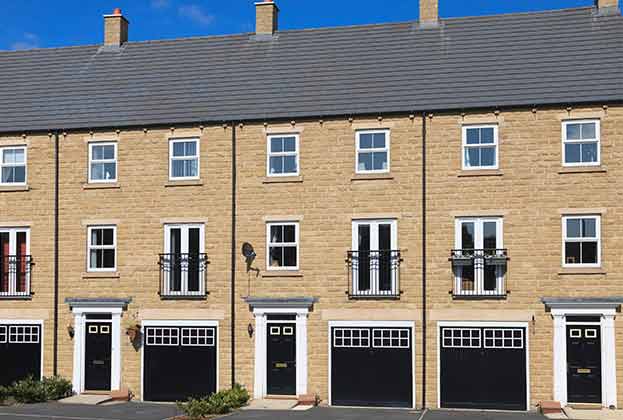Why bringing new sources of finance into the affordable housing sector has become ever more important
The rising cost of finance, the introduction of a cap on rent increases, and high inflation has put traditional HA budgets under increased pressure. Whilst the counter-cyclical delivery model has been critical to maintaining housing supply in previous downturns, constrained financial capacity means that HAs are unlikely to be able to deliver at higher volumes over the next five years. However, this does present more opportunities for FPRPs and investors to build their development programmes, particularly through the increased use of partnerships.
Shifting sector priorities
Many HAs are having to make difficult choices in how to allocate their spending going forward. 95% of respondents to our survey said that investment in existing homes and communities is more important to them than the development of new homes.
This is in sharp contrast to a survey we conducted in 2019, where just 41% of HAs prioritised existing homes. This marks the shift in the sector towards quality of service and customer satisfaction through management of existing stock. As a result, the ability and appetite of traditional providers to invest in new homes is restricted.
49% of HAs surveyed are planning to cut back on their development programme in order to pay for building safety and decarbonisation works, up from just 30% in 2021. Of these, 35% will cut more than a quarter of their development programme.
Financial strain on the sector
Since 2020, the sector’s financial capacity has been increasingly constrained. Multiple factors, such as the Covid-19 pandemic and the war in Ukraine, gave way to build cost inflation, labour shortages, an economic downturn, rising levels of inflation and a real terms rent cut. The rising cost of debt is also proving costly for those providers who have had to renegotiate debt arrangements.
On top of this, HAs have seen significant increases in spending levels on existing stock as a result of increasing standards on fire and building safety, a renewed Decent Homes Standard and decarbonisation targets. HAs spent a record £6.5 billion on existing stock in the year to March 2022, a 20% increase on the previous year. Concerns around stock quality have been further compounded by recent high-profile issues surrounding damp and mould.
Sector spend on existing stock is set to continue to increase with projections for a further £40.7 billion on repairs and maintenance over the next five years according to the 2022 Global Accounts published by the Regulator of Social Housing. In particular, large-scale investment is required in order to decarbonise HA stock. In 2020, Savills estimated that it would cost £35.8 billion for homes across the sector to achieve the minimum target of EPC Band C rating by 2030.
In recent years, HAs have been able to offset these rising costs by raising rents at a rate of CPI + 1% per year, in this case, 11.1% from April 2023. But from 2023/24, Government has set out that increases in social and affordable rents will be subject to a mandatory maximum increase of 7% in a bid to help tenants given the wider cost of living crisis. This cap on rent increases will cost HAs between £400 million and £1.2 billion in lost revenue. Some HAs are also implementing a voluntary 7% cap on Shared Ownership rents.
Counter-cyclical housing delivery
In recent months, the rising cost of debt, build cost inflation, falling house prices and the end of the Help to Buy scheme have led to a slowdown in the new build market. Declining sales activity has also fed through into reduced private housebuilding starts.
Demand for Shared Ownership is anticipated to be strong in the medium term as first-time buyers, facing rising mortgage rates and ongoing rental increases in the private rented sector, seek affordable home ownership options post-Help to Buy
Lydia McLaren, Associate Director, Residential Research
Historically, HAs have played a key role in delivering homes during wider development market downturns, being responsible for 43% of all new homes delivered in 2010/11 following the global financial crisis (GFC).
Given the end of the Help to Buy scheme, Shared Ownership has a key role to play in helping fill the gap in the new build market, aligning well with the preferred tenure of FPRP investors. Demand for Shared Ownership is anticipated to be strong in the medium term as first-time buyers, facing rising mortgage rates and ongoing rental increases in the private rented sector, seek affordable home ownership options post-Help to Buy.
Role of grant funding
Greater funding for the sector will be needed if HAs are to grow their share of overall housing delivery in addition to the large-scale requirements for existing stock. The Government has already allocated more generous grant funding in the 2021-26 Affordable Homes Programme at an average of £64,000 per unit. In 2021-22, grant funding accounted for 42% of affordable completions, the highest level since 2014-15. But with overall housing delivery expected to fall in the medium term, the supply of affordable homes through Section 106 will decrease. HAs are also finding that their grant funding doesn’t stretch as far in a high inflation, high interest rate environment.
In a bid to help keep the market moving in a weaker new build sales market no longer supported by Help to Buy, Homes England has recently announced that HAs can now use grants on completed homes originally built for market sale.
This will give developers more certainty to continue to build homes as they are able to mitigate risk through diversifying the tenure offering on larger sites.
Providing more Social Rent homes is a priority for the Affordable Homes Programme, in line with where there is the greatest need for affordable housing. There also remains significant potential for more affordable rented and intermediate housing options for older people which could be unlocked with the right policy support.
Read the articles within Spotlight: Private Capital and Affordable Housing below.
.jpg)
